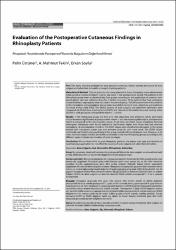| dc.contributor.author | Üstüner, Pelin | |
| dc.contributor.author | Tekin, Ahmet Mahmut | |
| dc.contributor.author | Soylu, Erkan | |
| dc.date.accessioned | 08.07.201910:49:13 | |
| dc.date.accessioned | 2019-07-08T20:18:43Z | |
| dc.date.available | 08.07.201910:49:13 | |
| dc.date.available | 2019-07-08T20:18:43Z | |
| dc.date.issued | 2017 | en_US |
| dc.identifier.citation | Üstüner, P., Tekin, A. M. ve Soylu, E. (2017). Evaluation of the postoperative cutaneous findings in rhinoplasty patients. Journal of Ankara University Faculty Medicine, 70(3), 175-181. https://dx.doi.org/10.1501/TÖpfak_000000983 | en_US |
| dc.identifier.issn | 0365-8104 | |
| dc.identifier.issn | 1307-5608 | |
| dc.identifier.uri | https://hdl.handle.net/20.500.12511/448 | |
| dc.identifier.uri | https://dx.doi.org/10.1501/TÖpfak_000000983 | |
| dc.description.abstract | Aim: This study aimed to evaluate the post—operative presence, clinical severity and course of acne vulgaris and seborrheic dermatitis among rhinoplasty patients. Material and Method: Fifty-six patients who were planned to have rhinoplasty were administered either pored or non-pored plaster cast for one week in the postoperative period.The patients in the rhinoplasty group were randomizedinto four groups according to the application of pored or nonpored plaster cast and adhesive strips for further one-week. Forty patients that had undergone closed technique-septoplasty were included in the control group. The self-assessments of the patients in the rhinoplasty and septoplasty groups were recorded in terms of acne,seborrhea and erythema via visual analog scale (VAS). The clinical severity of acne vulgaris andseborrheic dermatitis were compared via Global Acne Grading Score (GAGS) and Seborrheic Dermatitis Area and Severity Index (SDASI) in both groupsat postoperative months 1, and 6. Results: In the rhinoplasty group, the VAS acne, VAS seborrhea, VAS erythema, GAGS, and SDASI values increased significantly at postoperative month and decreased significantly at postoperative month compared to the pre-operative values. At all visits, the GAGS values of patients that had undergone rhinoplasty were found statistically significantly higher than those that had received septoplasty. At postoperative month 6, the GAGS values were significantly decreased in the group treated with non-pored plaster cast and adhesive strips for one more week. The SDASI values statistically significantly decreased only in the group treated with pored plaster cast. However, at all visits, the mean values of GAGS and SDASI were similar in the four rhinoplasty groups according to the different types of plaster cast duration of nasal bandages. Conclusion: We concluded that in post-rhinoplasty patients, the plaster cast type and duration of nasal bandage application do not affect the severity of acne vulgaris and seborrheic dermatitis. | en_US |
| dc.description.abstract | Amaç: Bu çalışmada, rinoplasti hastalarında postoperatif dönemde akne vulgaris ve seboreik dermatit varlığı, klinik şiddetleri ve seyirlerinin değerlendirilmesi amaçlanmıştır. Gereç ve yöntem: Rinoplasti planlanan 56 hastaya postoperatif dönemde bir hafta süreyle porlu veya porsuz alçı uygulandı. Rinoplasti grubundaki hastalar porlu veya porsuz alçı ve bir hafta süresince yapışkan bandaj uygulanmasına göre dört gruba rastgele dağıtıldı. Kapalı teknik septoplasti uygulanan 40 hasta ise kontrol grubuna alındı. Rinoplasti ve septoplasti gruplarındaki hastaların akne, sebore ve eritem bakımından kendi değerlendirmeleri görsel analog skala (GAS) ile kaydedildi. Her iki guptaki hastaların Global Akne Derecelendirme Ölçeği (GADÖ) ve Seboreik Dermatit Alan ve Şiddet İndeksi (SDASI) ile akne vulgaris ve seboreik dermatit klinik şiddeti postoperatif 1, ve 6. aylarda karşılaştırıldı. Bulgular: Rinoplasti grubunda VAS akne, VAS sebore, VAS eritem, GADÖ ve SDASI değerleri preoperatif döneme oranla postoperatif 1. ayda anlamlı oranda artmış, post--operatif 6. ayda anlamlı oranda azalmış idi. Tüm takiplerde rinoplasti geçiren hastaların GADÖ değerleri septoplasti olanlardan istatistiksel olarak anlamlı oranda daha yüksek bulundu. Postoperatif 6. ayda GADÖ değerleri porsuz alçı ve ek bir hafta süresince yapışkan bandaj ile tedavi edilen grupta anlamlı oranda azalmıştı. SDASI değerlerinin ise sadece porlu alçı ile tedavi edilen grupta anlamlı oranda azaldığı görüldü. Ancak, ortalama GADÖ ve SDASI değerleri farklı alçı tipleri ve burun bandaj sürelerine göre dört farklı rinoplasti grubunda da tüm takiplerde benzerdi. Sonuç: Bu çalışmada alçı tipi ve burun bandaj süresinin rinoplasti sonrası hastalarda akne vulgaris ve seboreik dermatit şiddetini etkilemediği sonucuna vardık. | en_US |
| dc.language.iso | eng | en_US |
| dc.rights | info:eu-repo/semantics/openAccess | en_US |
| dc.subject | Acne Vulgaris | en_US |
| dc.subject | Cast | en_US |
| dc.subject | Dermatitis | en_US |
| dc.subject | Rhinoplasty | en_US |
| dc.subject | Seborrhea | en_US |
| dc.subject | Akne Vulgaris | en_US |
| dc.subject | Alçı | en_US |
| dc.subject | Dermatit | en_US |
| dc.subject | Rinoplasti | en_US |
| dc.subject | Sebore | en_US |
| dc.title | Evaluation of the postoperative cutaneous findings in rhinoplasty patients | en_US |
| dc.title.alternative | Rinoplasti hastalarında postoperatif kutanöz bulguların değerlendirilmesi | en_US |
| dc.type | article | en_US |
| dc.relation.ispartof | Journal of Ankara University Faculty Medicine | en_US |
| dc.department | İstanbul Medipol Üniversitesi, Tıp Fakültesi, Dahili Tıp Bilimleri Bölümü, Deri ve Zührevi Hastalıklar Ana Bilim Dalı | en_US |
| dc.department | İstanbul Medipol Üniversitesi, Tıp Fakültesi, Cerrahi Tıp Bilimleri Bölümü, Kulak Burun Boğaz Hastalıkları Ana Bilim Dalı | en_US |
| dc.authorid | 0000-0002-7885-0537 | en_US |
| dc.identifier.volume | 70 | en_US |
| dc.identifier.issue | 3 | en_US |
| dc.identifier.startpage | 175 | en_US |
| dc.identifier.endpage | 181 | en_US |
| dc.relation.publicationcategory | Makale - Ulusal Hakemli Dergi - Kurum Öğretim Elemanı | en_US |


















